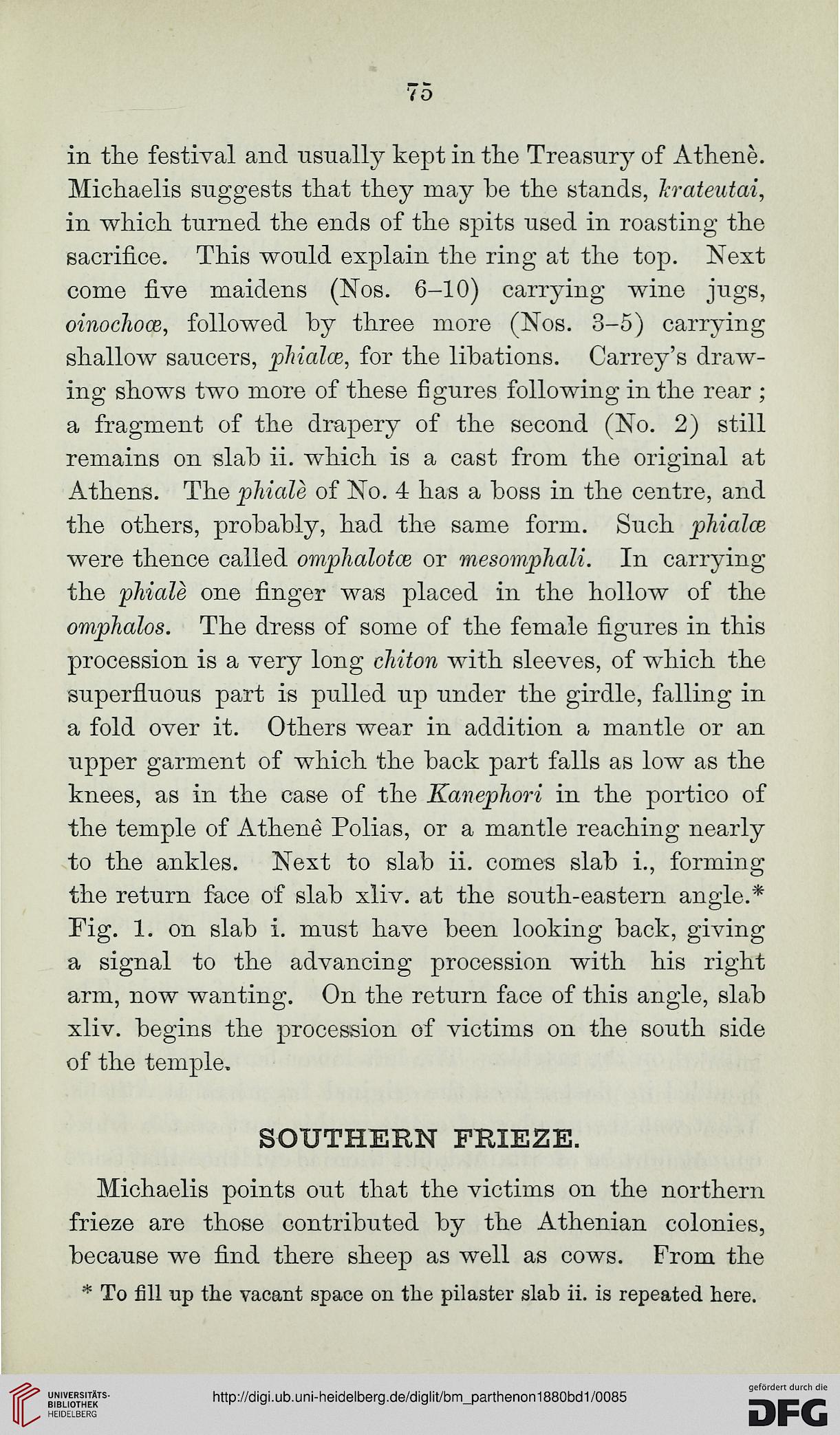y o
in the festival and usually kept in the Treasury of Athene.
Michaelis suggests that they may be the stands, krateutai,
in which turned the ends of the spits used in roasting the
sacrifice. This would explain the ring at the top. Next
come five maidens (Nos. 6-10) carrying wine jugs,
oinochoce, followed by three more (Nos. 3-5) carrying
shallow saucers, phialce, for the libations. Carrey's draw-
ing shows two more of these figures following in the rear ;
a fragment of the drapery of the second (No. 2) still
remains on slab ii. which is a cast from the original at
Athens. The phiale of No. 4 has a boss in the centre, and
the others, probably, had the same form. Such phialos
were thence called omplialotce or mesomphali. In carrying
the phiale one finger was placed in the hollow of the
omphalos. The dress of some of the female figures in this
procession is a very long chiton with sleeves, of which the
superfluous part is pulled up under the girdle, falling in
a fold over it. Others wear in addition a mantle or an
upper garment of which the back part falls as low as the
knees, as in the case of the Kanephori in the portico of
the temple of Athene Polias, or a mantle reaching nearly
to the ankles. Next to slab ii. comes slab i., forming
the return face of slab xliv. at the south-eastern angle.*
Fig. 1. on slab i. must have been looking back, giving
a signal to the advancing procession with his right
arm, now wanting. On the return face of this angle, slab
xliv. begins the procession of victims on the south side
of the temple.
SOUTHERN FRIEZE.
Michaelis points out that the victims on the northern
frieze are those contributed by the Athenian colonies,
because we find there sheep as well as cows. From the
* To fill up the vacant space on the pilaster slab ii. is repeated here.
in the festival and usually kept in the Treasury of Athene.
Michaelis suggests that they may be the stands, krateutai,
in which turned the ends of the spits used in roasting the
sacrifice. This would explain the ring at the top. Next
come five maidens (Nos. 6-10) carrying wine jugs,
oinochoce, followed by three more (Nos. 3-5) carrying
shallow saucers, phialce, for the libations. Carrey's draw-
ing shows two more of these figures following in the rear ;
a fragment of the drapery of the second (No. 2) still
remains on slab ii. which is a cast from the original at
Athens. The phiale of No. 4 has a boss in the centre, and
the others, probably, had the same form. Such phialos
were thence called omplialotce or mesomphali. In carrying
the phiale one finger was placed in the hollow of the
omphalos. The dress of some of the female figures in this
procession is a very long chiton with sleeves, of which the
superfluous part is pulled up under the girdle, falling in
a fold over it. Others wear in addition a mantle or an
upper garment of which the back part falls as low as the
knees, as in the case of the Kanephori in the portico of
the temple of Athene Polias, or a mantle reaching nearly
to the ankles. Next to slab ii. comes slab i., forming
the return face of slab xliv. at the south-eastern angle.*
Fig. 1. on slab i. must have been looking back, giving
a signal to the advancing procession with his right
arm, now wanting. On the return face of this angle, slab
xliv. begins the procession of victims on the south side
of the temple.
SOUTHERN FRIEZE.
Michaelis points out that the victims on the northern
frieze are those contributed by the Athenian colonies,
because we find there sheep as well as cows. From the
* To fill up the vacant space on the pilaster slab ii. is repeated here.




